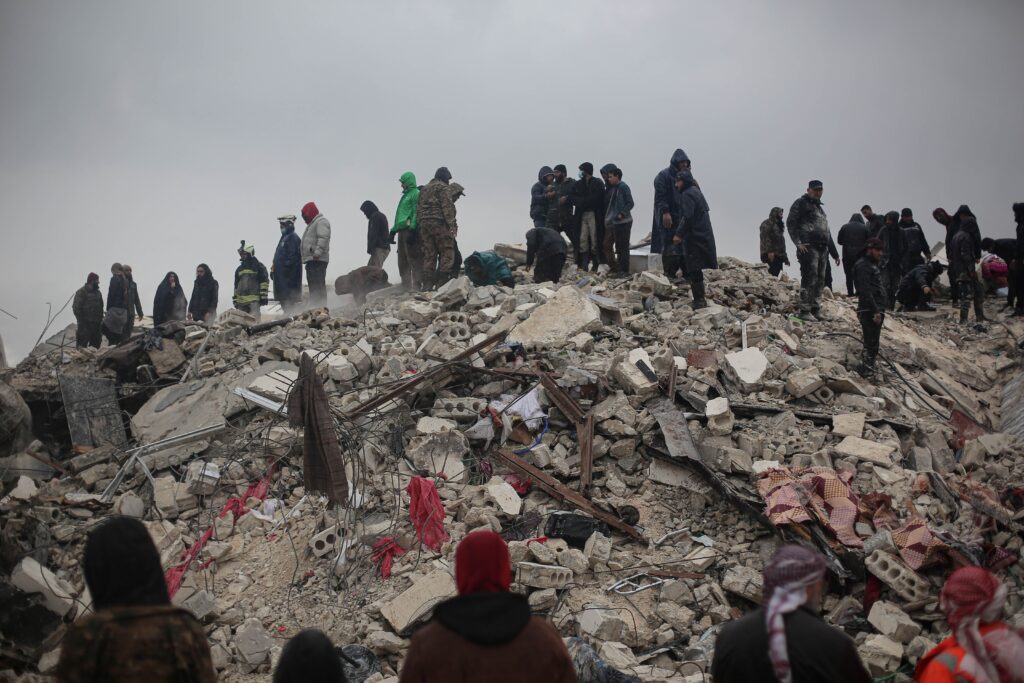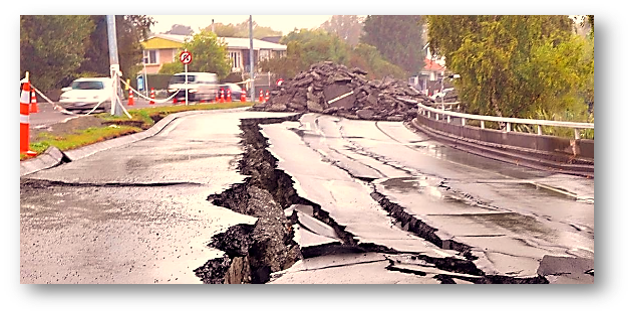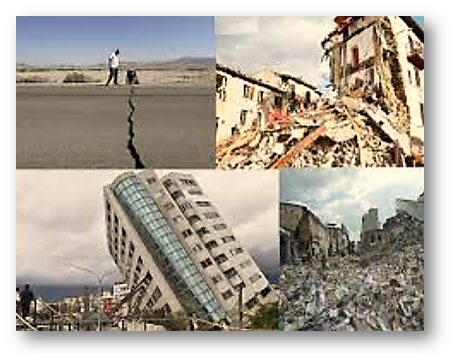An earthquake is a sudden, rapid shaking of the ground caused by the movement of tectonic plates in the Earth’s crust. Earthquakes can range in size from barely noticeable to devastating events that can cause widespread damage, injury, and death. The severity of an earthquake is determined by its magnitude (a measure of the energy released by the earthquake) and the intensity (a measure of the shaking experienced at a specific location). Earthquakes can occur at any time, anywhere in the world, but are most common along plate boundaries where large amounts of stress can build up in the Earth’s crust.

PHENOMENON OF AN EARTHQUAKE!!
An earthquake is a geological phenomenon that results from the movement of tectonic plates in the Earth’s crust. The movement of these plates creates tension in the Earth’s crust, which can lead to the release of energy in the form of seismic waves. This release of energy causes the ground to shake, producing the characteristic vibrations that we experience as an earthquake.

The tectonic plates that make up the Earth’s crust are constantly moving and interacting with each other. Which can result in earthquakes. This movement can occur along plate boundaries. Where two plates are moving apart from each other (divergent boundary), towards each other (convergent boundary), or sliding past each other (transform boundary). Earthquakes can also be caused by human activities such as underground mining, underground blasting, and the construction of large dams.
The magnitude of an earthquake is measured using the Richter scale. Which is a logarithmic scale that quantifies the amount of energy released by the earthquake. The intensity of an earthquake is measured using the Modified Mercalli Intensity Scale. Which is a qualitative scale that rates the intensity of ground shaking at a specific location.
Earthquakes can have a significant impact on both human societies and the natural environment. They can cause damage to buildings and infrastructure, trigger landslides and tsunamis, and result in the loss of life and property. However, they can also provide valuable information about the structure and composition of the Earth’s interior and can be used to study the process of plate tectonics.
IS THE PREDICTION OF EARTHQUAKES POSSIBLE??
The prediction of earthquakes is a complex and challenging scientific endeavor. And there is currently no reliable way to predict when an earthquake will occur with complete certainty. However, significant progress has been made in understanding the processes that lead to earthquakes. And scientists are using this information to develop methods for earthquake forecasting. Which provides a probabilistic estimate of the likelihood of an earthquake occurring in a given region over a specified period.
There are several methods used to forecast earthquakes, including statistical models, physical models, and machine learning algorithms. These methods are based on various factors. Such as the history of past earthquakes, the current rate of plate movement and stress accumulation, and changes in the Earth’s crust and surface.
In addition, scientists are also working to develop early warning systems. That can provide a few seconds to several minutes of warning before an earthquake strikes. These systems use seismic data to rapidly detect and characterize the onset of an earthquake and provide an estimate of the expected ground motion. Allowing people to take appropriate action to protect themselves.
While there is still much work to be done in the field of earthquake prediction. The development of earthquake forecasting and early warning systems is an important step in reducing the impacts of earthquakes on communities around the world.
WORLD EARTHQUAKE TIMELINE!!

Here is a brief timeline of some of the most significant earthquakes in world history:
365 CE:
A massive earthquake strikes the eastern Mediterranean, causing widespread destruction in the region, including the city of Alexandria, Egypt.
1556 CE:
A magnitude 8.0 earthquake strikes Shaanxi, China, killing an estimated 830,000 people and becoming one of the deadliest earthquakes in recorded history.
1755 CE:
A magnitude 9.0 earthquake strikes Lisbon, Portugal, causing widespread damage and leading to a tsunami that affects the coastlines of Spain and Portugal.
1857 CE:
A magnitude 7.9 earthquake strikes Fort Tejon, California, USA, causing widespread damage along the San Andreas Fault.
1906 CE:
A magnitude 7.8 earthquake strikes San Francisco, California, USA, causing widespread damage and leading to a fire that devastated much of the city.
1964 CE:
A magnitude 9.2 earthquake strikes Alaska, USA, becoming the largest earthquake ever recorded in North America.
1976 CE:
A magnitude 7.8 earthquake strikes the city of Tangshan, China, killing an estimated 240,000 people and becoming one of the deadliest earthquakes in modern history.
1989 CE:
A magnitude 6.9 earthquake strikes the San Francisco Bay Area, California, USA, causing widespread damage and leading to the collapse of the Nimitz Freeway in Oakland.
2011 CE:
A magnitude 9.0 earthquake strikes off the coast of Japan. Triggering a massive tsunami that causes widespread damage and the failure of the Fukushima Daiichi Nuclear Power Plant.
These earthquakes serve as a reminder of the destructive power of these geological events and the importance of preparedness and disaster response planning.
SIGNS OF EARTHQUAKE!!
There are several signs that an earthquake may be imminent, including:
Strange animal behavior:
Some animals, such as dogs and cats, can sense the vibrations and changes in the atmosphere before an earthquake. And may exhibit strange behavior, such as barking or meowing excessively.
Ground disturbances:
Some people have reported observing small cracks in the ground, sinking or rising of the land, or a sudden appearance of springs or wells before an earthquake.
Changes in water level:
Some earthquakes have been preceded by changes in the water level of wells or lakes or the sudden appearance of new bodies of water.
Unusual sounds:
Some people have reported hearing strange sounds, such as rumbling, whistling, or humming before an earthquake.
Strong electromagnetic signals:
Some earthquakes have been preceded by strong electromagnetic signals that can be detected by sensitive instruments.
It is important to note that these signs are not always reliable. And can also be associated with other natural phenomena. Additionally, most earthquakes occur without any noticeable precursors. Therefore, it is important to be prepared for earthquakes at all times. And to follow recommended safety procedures during and after the event.
AFTEREFFECTS OF EARTHQUAKE!!
The aftermath of an earthquake can be devastating and can have a range of social, economic, and environmental impacts. Some of the common after-effects of earthquakes include:
Structural damage:
Earthquakes can cause extensive damage to buildings, bridges, roads, and other infrastructure, resulting in the collapse of buildings, roadblocks, and loss of communication networks.
Landslides and rockfalls:
Earthquakes can trigger landslides and rockfalls, which can cause additional damage to buildings and other structures and pose a threat to people and animals.
Tsunamis:
Some earthquakes, particularly those that occur beneath the ocean floor, can generate tsunamis, which are massive ocean waves that can inundate coastal communities and cause widespread damage.
Fire:
Earthquakes can also cause fires, either by rupturing gas lines, knocking over candles or stoves, or damaging electrical systems.
Water contamination:
Earthquakes can contaminate water supplies by breaking pipelines and mixing water with sewage and chemicals.
Displacement of people:
Earthquakes can force people from their homes, leading to temporary or long-term displacement, and can also result in the loss of livelihoods and the need for temporary or permanent relocation.
Psychological effects:
Earthquakes can have profound psychological effects on individuals and communities, causing stress, anxiety, and depression, and can result in long-term mental health problems.
It is important to be prepared for earthquakes and to have a plan in place for responding to the aftermath. Including securing adequate food, water, and medical supplies, as well as providing support for those who have been affected by the disaster.
KEYWORDS:
Seismic activity, Tectonic plates, Epicenter, Richter scale, Magnitude, Ground motion, Shaking intensity, Fault, Aftershocks, Tsunami, Landslides, Ground failure, Building codes, Emergency response, Risk assessment, Public Education, Infrastructure development, Research, and development, Evacuation plan, Secondary hazards, Earthquake preparation, earthquake safety tips, earthquake protection, earthquake hazard reduction, risk assessment, response plan, insurance, -resistant buildings, early warning systems, education and awareness, secondary hazards, aftermath management, recovery and rebuilding earthquake research and development, prediction and forecasting,
REFERENCES:
https://www.aljazeera.com/news/liveblog/2023/2/9/turkey-syria-quake-updates
https://lifebiologs.com/every-behavior-is-a-choice-be-conscious/

Pingback: GLOBAL WARMING AND EARTHQUAKES!! - Life Biologs
My sibling advised me to visit this site, and he was entirely correct. This post truly brightened my day. I cannot even begin to express how much time I had devoted to gathering this information. Many thanks.